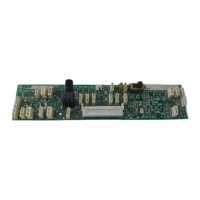7
AMPLUS™ 100 THEORY OF OPERATION
Introduction:
The AmPlus 100 Business Music Amplifier is a two channel amplifier intended for business
music and other installed sound systems. Its two inputs pass through the Opti-Voice
®
Page and
Opti-Source™ Option Cards and Equalizer cards, if they are installed. These cards expand the
number of inputs and outputs of the basic AmPlus 100, adding special features of paging, source
selection, and priority override.
Sheet 1 of 3
Refer to the AmPlus 100 schematic diagram, sheet 1 of 3 for the following information.
Note: The designators inside the brackets “[ ]” are the schematic grid coordinates which
are provided in order to make it easier to locate components on the schematic sheet
indicated in the description.
The Channel 1 and Channel 2 Inputs at J1 [D8] are the "A" inputs on the AmPlus 100
and accept line level sources. U100A [D7] and U101B [C7] are unity gain, differential input
amplifiers, with inputs well protected against RF and ESD. Ch 2 coming from U101B can
pass through S1 [D7], the Mono/Dual Mono/2-Ch switch, in the 2-Ch position. In other
positions of S1, Ch 2 is ignored unless S7 [C7], the 2-Ch/Mixer switch, is in the Mixer
position, in which case Ch 2 and Ch 1 are mixed in the proportion set by R1 and R2, the
Ch 1 and Ch 2 gain trim switches. After buffers U106A/B, the Ch 1 and Ch 2 signals are
presented to one of the two inputs of U102 [D6] and U103 [C6], op amps with a pair of
input stages and a selector mechanism, acting as a selector switch. If no option card is in
the #1 position at J2 [C7], U102/103 pass the Ch 1 and Ch 2 A input signals straight
through; if either a source or a page option card is in the #1 slot at J2, its output will be
selected to pass forward into the AmPlus 100 signal path.
If an option card is installed in the #1 slot at J2, then the Ch 1 and Ch 2 A input signals
are sent to the option card, and will be processed on that option card and returned to the
AmPlus 100 along with the other signals contributed by the option card. The switching
action of U102/103 is controlled by the DC level on pin 1. Normally, with no option card in
the #1 slot at J2, this pin is pulled high, but when an option card is in place it shorts J2-5,
pulling U102/103 pin 1 toward ground.
Continuing forward on Sheet 1, [coordinates 5D and 5C], the Ch 1 and Ch 2 signals
encounter another pair of switched op amps, U104/105 and the option card #2 connector
at J3 [C6]. Signal flow here is handled in the same manner as around option card #1: if no
option card is installed in slot #2 at J3, the signals pass through; otherwise, they enter the
option card and are processed along with that card's sources before being returned to the
main AmPlus 100 signal path.
Equalizer cards can be placed in J9 [D5] (for Ch 1) and in J10 [C5] (for Ch 2). If there is
no EQ card in J9, the output from U104 passes through the unity gain buffer U100B, but
if there is an EQ card, it "overrides" the signal from U104, substituting equalized audio from
the EQ card. A similar arrangement for Ch 2 uses U101C. Special switching in the Ch 2
path after U101C allows the use of a single EQ card in the J9 slot in the cases where the
source is being handled in mono or dual mono (in dual mono, R3, the Zone 2 Trim, is
engaged). When the switch S1 is in the Mono or Dual Mono position, the Ch 1 signal is
taken through an inverting stage (U101A) and passed to the Ch 2 path. Inverting the
signal phase for the CH2 output compensates for the fact that the connector for the Ch 1
output results in the Ch 1 speaker signal also being inverted. U105 provides this phase
inversion for Ch 2 signals when S1 is in the two channel mode.

